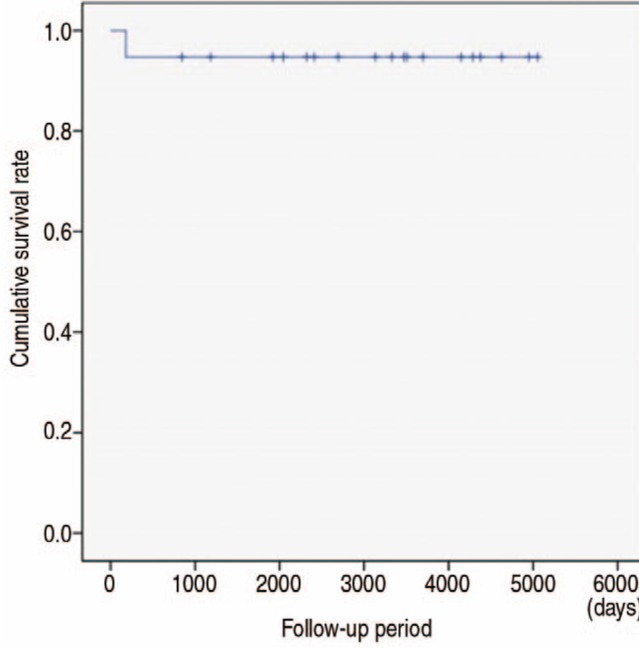Hip Pelvis.
2018 Mar;30(1):23-28. 10.5371/hp.2018.30.1.23.
Medium- to Long-term Results of Strut Allografts Treating Periprosthetic Bone Defects
- Affiliations
-
- 1Department of Orthopaedic Surgery, Inha University School of Medicine, Incheon, Korea. moon@inha.ac.kr
- KMID: 2408182
- DOI: http://doi.org/10.5371/hp.2018.30.1.23
Abstract
- PURPOSE
We evaluated the medium- to long-term outcomes of cortical strut allografts used to treat periprosthetic bone defects to better understand the correlation between radiological and clinical outcomes.
MATERIALS AND METHODS
We retrospectively reviewed outcomes from 19 patients undergoing cortical strut allografts to treat periproshtetic bone defects from 2001 to 2015. The mean age at index operation was 59.4 years and the average follow-up period was 8.6 years. Surgeries were performed because of aseptic loosening (n=9), periprosthetic fractures (n=5), and infections (n=5). Each case was characterized and described in detail including the length of allograft and the union period; possible correlations between allograft length and detailed classification and union period was analyzed. Clinical evaluations included the Harris hip score and Kaplan-Meier survivorship.
RESULTS
In revision total hip arthroplasty (THA), the average length of allografts used in patients experiencing fractures was significantly longer than those with aseptic loosening or infection. Of the 19 cases, incorporation was observed in 18 cases (94.7%). The average time to incorporation was 21.2 months and the time to incorporation was not significantly different among the two groups (fracture vs. aseptic loosening or infection). No positive correlation was identified between the length of allograft and incorporation period or in the time to cortical strut allograft incorporation among Paprosky or Vancouver subgroups.
CONCLUSION
Results of cortical strut allografts show excellent incorporation rates based on medium- to long-term follow-up. Cortical strut allografts may be considered useful for the treatment of femoral bone defects experienced during revision THA and following periprosthetic fracture.
MeSH Terms
Figure
Reference
-
1. Kurtz S, Mowat F, Ong K, Chan N, Lau E, Halpern M. Prevalence of primary and revision total hip and knee arthroplasty in the United States from 1990 through 2002. J Bone Joint Surg Am. 2005; 87:1487–1497. PMID: 15995115.
Article2. Kurtz SM, Ong KL, Schmier J, et al. Future clinical and economic impact of revision total hip and knee arthroplasty. J Bone Joint Surg Am. 2007; 89(Suppl 3):144–151. PMID: 17908880.
Article3. Barden B, Fitzek JG, Huttegger C, Löer F. Supportive strut grafts for diaphyseal bone defects in revision hip arthroplasty. Clin Orthop Relat Res. 2001; (387):148–155. PMID: 11400876.
Article4. Gross AE, Blackley H, Wong P, Saleh K, Woodgate I. The role of allografts in revision arthroplasty of the hip. Instr Course Lect. 2002; 51:103–113. PMID: 12064094.5. Head WC, Malinin TI. Results of onlay allografts. Clin Orthop Relat Res. 2000; (371):108–112.
Article6. Hamer AJ, Suvarna SK, Stockley I. Histologic evidence of cortical allograft bone incorporation in revision hip surgery. J Arthroplasty. 1997; 12:785–789. PMID: 9355008.
Article7. Paprosky WG, Lawrence J, Cameron HU. Femoral defect classification: clinical application. Orthop Rev. 1990; 19(Suppl 9):9–15.8. Wang JW, Wang CJ. Periprosthetic fracture of the femur after hip arthroplasty: The clinical outcome using cortical strut allografts. J Orthop Surg (Hong Kong). 2000; 8:27–31.
Article9. Kligman M, Rotem A, Roffman M. Cancellous and cortical morselized allograft in revision total hip replacement: A biomechanical study of implant stability. J Biomech. 2003; 36:797–802. PMID: 12742447.10. Emerson RH Jr, Malinin TI, Cuellar AD, Head WC, Peters PC. Cortical strut allografts in the reconstruction of the femur in revision total hip arthroplasty. A basic science and clinical study. Clin Orthop Relat Res. 1992; (285):35–44.11. Head WC, Malinin TI, Mallory TH, Emerson RH Jr. Onlay cortical allografting for the femur. Orthop Clin North Am. 1998; 29:307–312. PMID: 9553575.
Article12. Lim CT, Amanatullah DF, Huddleston JI 3rd, Hwang KL, Maloney WJ, Goodman SB. Cortical Strut Allograft Support of Modular Femoral Junctions During Revision Total Hip Arthroplasty. J Arthroplasty. 2017; 32:1586–1592. PMID: 28130016.
Article13. Gross AE, Wong PK, Hutchison CR, King AE. Onlay cortical strut grafting in revision arthroplasty of the hip. J Arthroplasty. 2003; 18(3 Suppl 1):104–106. PMID: 12730942.
Article14. Head WC, Hillyard JM, Emerson RH Jr, Peters PC Jr. Proximal femoral allografts in revision total hip arthroplasty. Semin Arthroplasty. 1993; 4:92–98. PMID: 10148550.
Article15. Barden B, Ding Y, Fitzek JG, Löer F. Strut allografts for failed treatment of periprosthetic femoral fractures: good outcome in 13 patients. Acta Orthop Scand. 2003; 74:146–153. PMID: 12807320.
Article16. Schmidt AH, Kyle RF. Periprosthetic fractures of the femur. Orthop Clin North Am. 2002; 33:143–152. PMID: 11832318.
Article17. Engh CA, Massin P. Cementless total hip arthroplasty using the anatomic medullary locking stem. Results using a survivorship analysis. Clin Orthop Relat Res. 1989; (249):141–158.
- Full Text Links
- Actions
-
Cited
- CITED
-
- Close
- Share
- Similar articles
-
- Intramedullary fibula strut bone allograft in a periprosthetic humeral shaft fracture with implant loosening after total elbow arthroplasty
- Periprosthetic Fracture after Locked Plating in the Osteoporotic Long Bone Fracture
- Revision Total Hip Arthroplasty with a Strut Allograft and an Extensively Porous-Coated Femoral Stem
- Revision Total Hip Arthroplasty of an Acetabular Cup with Acetabular Bone Defects
- Periprosthetic Fracture around Tumor Prosthesis, Comparison of Results with or without Cortical Strut Onlay Allograft




